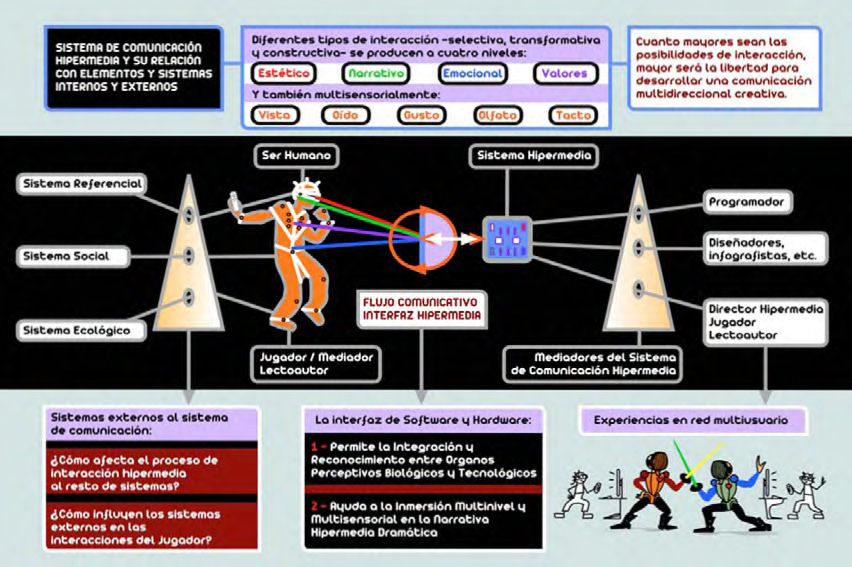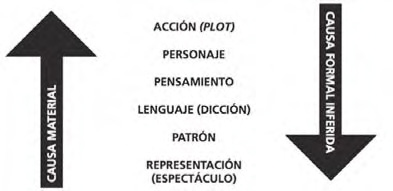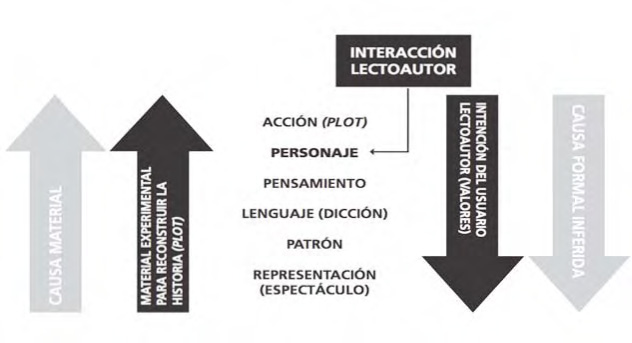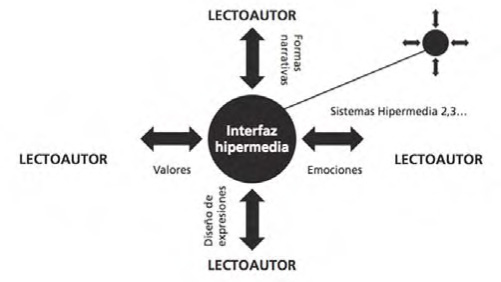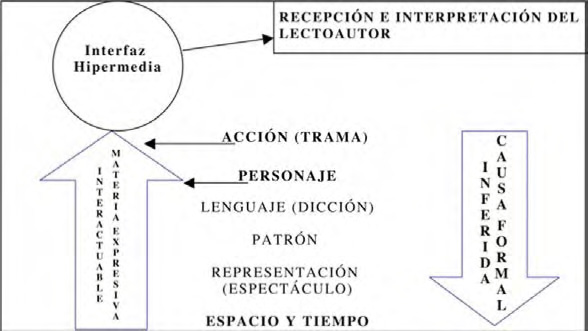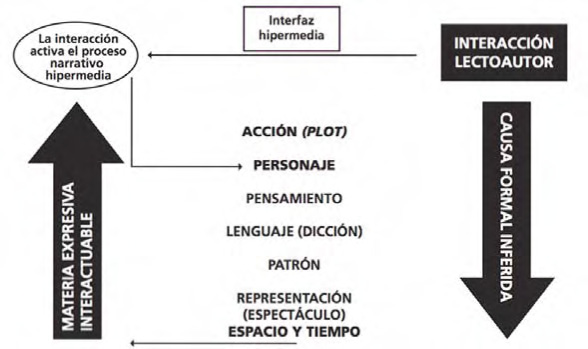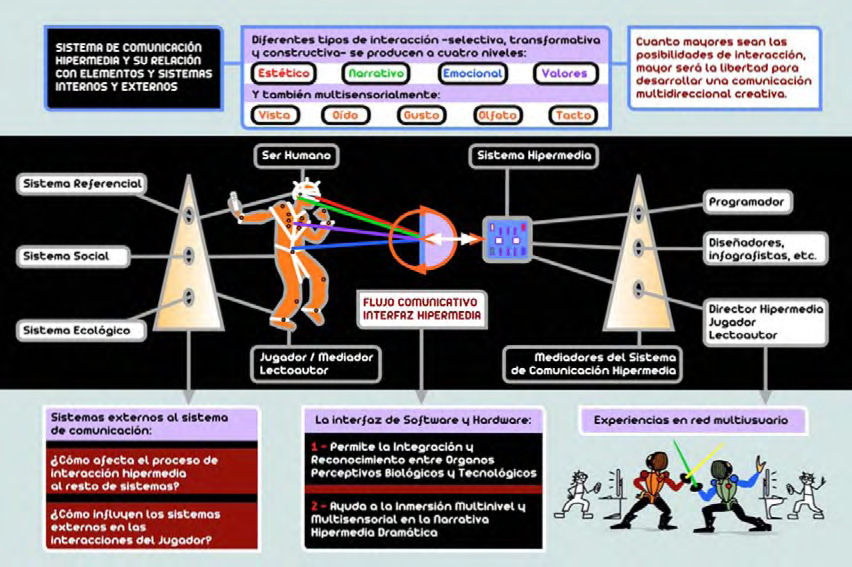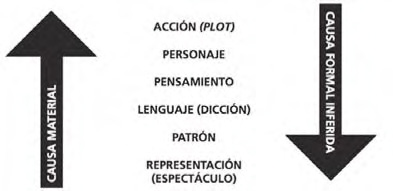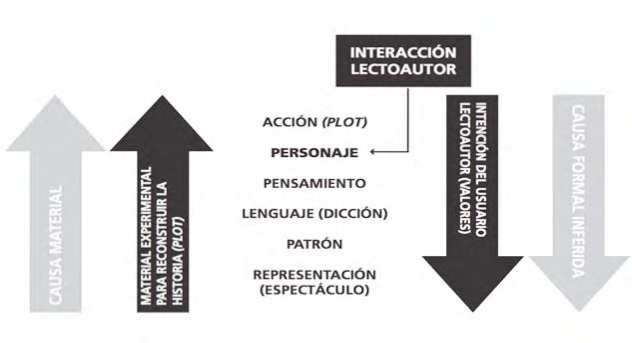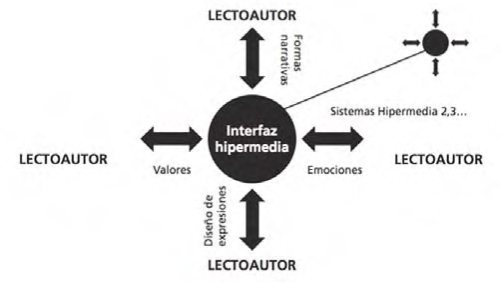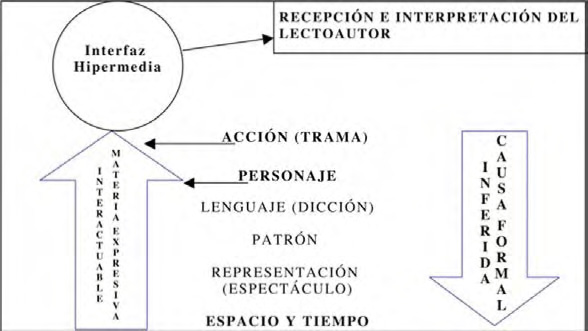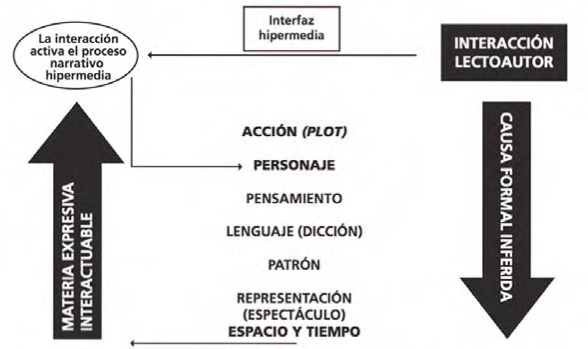Pulsa aquí para ver la versión en Español (ES)
Abstract
This paper compiles data on how the use of hypermedia, interactive multimedia and interfaces have changed the classical dynamics of human communications and education to create a new paradigm. This paradigm originates in the interface since it allows multidirectional and multimedia communications through interactions with the elements of which it is composed. This research describes the different aesthetic, narrative, emotional and value elements that are integrated within the cultural hypermedia interfaces. These hypermedia elements are fundamental components to be taken into account in the creation of educational interactive media products. The communicative functions are interchangeable between sender-receptor, author-reader-author, creator-user, professor-student... thanks to the introduction of multimedia interactive expressions and technological instruments that allow several types of interactions. This flexible functionality generates new communicative as well as dramatic models of interactive narrative, where the interaction of receptors-senders and reader-authors with the narrative actions occur at the character or avatar level. The interfacial aesthetic, narrative, emotional and value elements are studied, analyzed and described in detail thanks to an innovative model of analysis that can be used to for the implementation and design of interactive edutainment media products. The application of this model helped to create cultural content interfaces enabling not only the development of interactive educational workshops in the USA, Peru and Bolivia for more than 200 students, but also multisensory and immersive communications with quality.
1. Introduction. The hypermedia interface as the new paradigm of communication
The start of the 21st century has seen a huge increase in the number of hours the youth spend on using new technologies, which has led to numerous studies into why video games are so attractive. The model presented in Epigraph 3.3 can be used and redirected for the transmission of cultural and educational content through new media. Gee (2003: 200-212) underlines the importance of studies from the perspective of learning about the new media elements that young adults find most attractive.
To study the hypermedia interface was the main purpose of this research since it is the main technological and expressive channel that gives access to interactive and multidirectional media communications. New media integrate the qualities of interactivity and multimedia within the digital interfaces. The hypermedia interface is changing the human communication system due to its interactive ability as well as the multisensory qualities of the hypermedia. Each hypermedia element that forms part of the interface is located exactly between the information flow generated by several communicative actors, the original author of the interactive media product and its users, players, students or receptors. According to Osorio & Duart (2010) «interaction can be defined as the cognitive and social actions between the actors of the educative process (student-professor, student-student) in the development of the learning activities». The term interactivity used in this research is also similar to the definition given to it by Meadows (2003: 37-39) «to denote the relationship between the human/s through an object, the computer [...] The interactivity requires the fulfillment of a series of guidelines to have flow».
This approach can also be used to answer important contemporary questions in the area of educommunication and alphabetization with new media. Questions that are important to find answers to, such as: how can we develop immersive interfaces for educational content?, or González-Faraco and Gramigna’s (2009) statement that «by studying both the logic of video games and how players understand them, we can develop interesting ideas for re-thinking theories on knowledge and education».
The interface is defined by the «RAE dictionary», «Diccionario de la Real Academia de la Lengua Española», as «the physical and functional connection between two devices or independent systems». «The New Oxford American Dictionary» describes the interface as «a point where two systems, subjects, organizations, etc, meet and interact». In this sense, the interface is the physical and functional connection between the interactive communicative system, its interactive aesthetic and narrative expressions and the human system of perception and communication. It is Moreno-Muñoz´s (2000: 114) definition that fits best with this research: «the mixture of hardware and software that the reader-author uses to communicate with the hypermedia program». The interface synthesizes the conjunction of interactive expressions and educational content organized within the multi-sensorial representations permitted by informatics. The author-sender of the didactic communication manages the technological possibilities in order to transmit educational representations and narratives. Thus, he will try to create original expressions organized in an attractive multimedia form that can stimulate a new interaction in the student. Then, he becomes a reader-author, receptor-sender, even student-professor committed to the learning process. The main goals and motivation behind this research were to find those principles that add quality and depth to interactions with the hypermedia interface and the edutainment content.
2. Material and methods
The material and methods used in this research integrate an interdisciplinary approach that results from the complexity of the hypermedia interface. It includes areas of interactive communication and narrative with perception, education and psychology, among others. The following materials observe and describe how the original form of that fusion between communicative expressions and narrative representations occurs thanks to the hypermedia interface. This research was initially conducted by the application of new models of communication and analysis of the hypermedia elements, tested on several educational interfaces over a period of 8 years using discussion groups, surveys, questionnaires, multi-camera observations, content analysis, etc. The models presented have been applied to different educational and cultural interactive media projects, and this paper includes the improved versions of these models. The conclusions of previous research were applied to several projects, like the creation of an online interactive museum (www.multiculturalvideos.org) presented at the Communicability Workshop, ACM Multimedia Conference (Mora, 2008), or the prototype which won awards for a massive cultural multiplayer online game called Exchanging Cultures EC Game. These conclusions were also applied to the design and software selection of the international cooperation educational intervention for hypermedia alphabetization in Peru and Bolivia, within a group of 200 students. Thanks to the application of these models successful interactive educational workshops were developed, and the most immersive digital video editing software was selected for use during the intervention, e.g.: Final Cut, Premiere and Sony Vegas. The implementation of new innovative models of analysis of hypermedia interfaces were developed and tested during this process, and the results are detailed in the epigraph that follows. These models can be used in educational environments, cultural videogames, interactive museums, cinema, webs, digital journalism and augmented reality.
2.1. Sample group and description of the experience
This interactive educational strategy and models were field tested, confirmed and applied in one recent international cooperation experience between USA and Spain, in Peruvian and Bolivian educational and cultural institutions in the cities of Cusco, Puno, La Paz and Oruro, with the participation of approximately 200 students during the summers of 2010 and 2011. As Arcila & Said (2011) underlined «According to the results, a good part of digital media in Latin America are incorporating web 2.0 tools, but there still exist notable quality differences in the ranking proposed between the best rated media (Colombia and Mexico) and the worst rated (Chile and Bolivia)». The cooperative goal was to introduce and educate Peruvian and Bolivian artists and students in audiovisual and multimedia communications, using hypermedia interfaces and software for digital video editing. This way they were able to develop videos for the Internet while audovisually promoting and conserving their Quechua, Aymara and contemporary Andean cultures.
To obtain that goal, several video editing interfaces such as Final Cut, Adobe Premiere and Sony Vegas were offered to the students, and installed on their own computer stations or on those brought by the cooperating organizations. These software programs were the most current versions and were compatible with PC or Mac systems, so every student could find a familiar way to interact and learn through the process. Moreover, we brought the most updated and/or expressive versions, so the students could have hypermedia interfaces to materialize the representations and contents they wanted through easy immersive interactions. The classes were also designed to be interactive, so after a brief and synthesized explanation about writing a script, organizing technical equipment for recording, or about capturing and editing the recorded images, the students could interact with the equipment and the software interfaces. Finally, they were able to apply the lessons, expressing and materializing their representations right away by using the hypermedia interfaces. That way they also helped implement the teaching techniques during the experience, since they were very interactive with the lessons, the tools and the contents they were using. The results were surprising: 10 videos, 10 minutes each, were produced in a week, made by groups of three to seven members, in a class of 60-70 students per city. There were a total of 45 videos, and the experience also allowed the implementation of the model of analysis of effective hypermedia interfaces, presented here in the following epigraph 3.3.
2.2. Methods applied for observing the interactive communications
The following systems were applied during the research experience to implement the dynamics of alphabetization in media literacy. The traditional dialectic system of mass media communication developed by Martín-Serrano (1982: 159-174) is presented in Figure 1, and contrasted with the model in Figure 2, which includes the new elements that the hypermedia communication system integrates.
The hypermedia interface can be located in the center of the cross in Figure 2 since it interconnects and interexchanges all the communication elements: actors, expressions, representations and instruments.
In the hypermedia communicative system, the positions and functions of the communicators change over time, when the communicative phenomenon is produced through interactivity. The hypermedia interface allows this exchange of roles since it integrates multi-sensorial expressions with different types of interactions. The actor looks forward to communicating his own representations through the interface, whether, he is communicating with an artificial intelligence (AI) system such as a one-player video game, or with other human actors, such as playing in a massive multiplayer online game (MMOG). Afterwards, the receptor actor decodes mentally and emotionally the representations contained in the multimedia expressions presented through the interface. Then, the differential moment of the interactive communication is when the motivated actor decides to activate the multi-directional system of communication, using his interactions over the hypermedia interface, and coding his own representations to communicate them to a new receptor, a.k.a. reader-author, student-professor, author-reader, or the first sender. The most characteristic moment is when the exchange of roles between actors occurs: the sender becomes the receptor and vice versa. If this main characteristic of the hypermedia system is taken into account in the pedagogical development of new and interactive media materials, classes and courses, future generations will be more able to participate in their own learning processes, thus producing better objective results. In that sense, the hypermedia system is ideal for the construction of culture, since it can be an open system for the exchange and discussion of ideas.
The differential characteristic of hypermedia communication is not only the exchange of functions between the actors of communication as a result of the technological tools, but also the fusion of traditional communications media and digital computing technology (Manovich, 2001: 25), all that allows for a new system of communication that is interactive and multimedia. Any type of expression is potentially able to be used. That is why the multimedia aspect is the one that, with the interactivity, better defines the hypermedia communication system.
A diagram, based on the different educational and communicative experiences analyzed using hypermedia interfaces, has been created for describing the elements and systems that participate in the interactive communications. Presented in Figure 3, it synthesizes in a general, iconographic and schematic way all the elements and systems that interact with and within the hypermedia communication system. It gives us a clear overview of the original aspects of the hypermedia communication system and how it configures a new model of communication and system of interactions.
2.3. Methods applied to analyze the interactive narrative
There is a new dramatic theory for interactive narrative systems developed in several schemas by Mateas (Wardrip-Fruin & Harrigan, 2004: 22), see Figures 4 and 5. The immersion or the mediatory identification is generated in the hypermedia communication through the interaction with the character or through the actions of the reader-author. All the following expressive elements can be interactional; it is possible to do an expressive communicative interaction about them. However, within the hypermedia communication system, it is at the level of the character and the actions that the avatar, the reader-author or player, materializes the expressive interaction, the immersion or the mediatory identification. That is why the expressive elements that appear in the interface are described as elements that serve the interaction and construction of the character or avatar. Shown below, in two schemas, are the differences between the dramatic theory by Aristotle and the updated schema purposed by Mateas.
Mateas (Wardrip-Fruin & Harrigan, 2004: 22-23) gives an explanation of the traditional schema: Aristotle analyzes the works in hierarchical categories, in the center of the schema, corresponding to the different parts of the creation. Those categories are related through formal and material causes. The material cause of something is the material from which is created. The expressive material, from the perspective of communications theory, is compounded by the multimedia expressions and the characteristics of the hypermedia narrative. The formal cause is the abstract plan, the goal or the ideal through which something is directed. The motivational goal, the organized expressions and the narrative structures are created to transmit a plot or theme, which is then associated with certain values. This is also done within interactive media so that it becomes more successful. Kojler (2005: 272) underlines how the most popular Japanese video games have used cinematographic techniques to attract interaction. The video game Donkey Kong from Miyamoto was the first one to introduce a narrative of start/ middle/end in a video game and the narrative structure has been very influential over other games: «from the Electronic Gaming Monthly’s 2001 list from the 100 better video games, 78 had elements of narrative lines and another eight recognized at least clear characters».
In the new model of the interactive drama, Mateas (Wardrip-Fruin & Harrigan, 2004: 22-23) explains «the player has been added to the model as a character who can choose his own actions. This has a consequence».
The player, reader-author, organizes his interaction plan and directs it through the character category.
The player collaborates, or can collaborate, in the construction of the proper narrative forms to communicate a plot or theme, with their corresponding values, coming from both the author and the player of the game. Mateas (Wardrip-Fruin & Harrigan, 2004: 22) continues describing the function of the interactive drama in the game in the following manner «But this ability of taking action is not completely free; it is limited from behind by the material resources…». The interactive multimedia expressions, as well as the spatial and temporal variables, become the constrictions that the game offers, «…and from over it by the formal authorial cause originated at the level of the plot». The author directs the theme of the game or interactive narrative and the main actions of the plot. The English term «affordance», which, when applied to hypermedia can be translated as the availability of interactive multimedia expressions, is also a constriction to the interactions. Nevertheless, this constriction can be made up through the interface design, within a broad variety of hypermedia expressions. When the interaction is attracted by some expressions and developments of the dramatic plot, it would generate a more engaging interaction. The fact that the forms of interaction can be developed through some or all perceptual senses of the player, also means a level of constriction or freedom depending upon the adaptation of the technological tools of the game to the biological senses of the player. This happened for instance with the original Eyetoy, from Sony, most recently with the Wii, from Nintendo, or lately with the Kinect, from Xbox 360.
3. Results
The original interdisciplinary integration of the previous new models, specially of the previously presented interactive communication and narrative models, lead to the creation of integrated and innovative models for analyzing hypermedia interfaces, which have been proved during the research experiences. In the most recent experience in Peru and Bolivia, a remarkable total of 45 videos were produced in 4 one-week workshops. They were created through the interaction of both first time and initiated audiovisual and multimedia practitioners. A remarkable experience was to observe how the interactive communication system and the new technologies helped the development of media literacy in multiple contexts. Moreover, using an interactive educational model served not only to produce great quantities of videos in a short period of time, thereby letting students learn through completing the whole production process, but also contributed to the quality of the video narratives and techniques: 65% of the videos produced during the workshops had semi-professional quality. Some of the videos were even presented later on in video festivals or even projected on a Bolivian national TV, like the ones titled «Watxia Ritual» or «Paqarina», which are still online on the channel www.youtube.com/multiculturalvideos.
3.1. Validity and functionality of the resulted models
The validity and functionality of the following models of analysis of the hypermedia interface has been proven in several previous scientific researches such as on «Smoke & Mirrors», developed by Sheldon Brown, ex-director of the Center for Research in Computing and the Arts from the University of California San Diego. Moreover, these models of analysis were corrected and they were used as descriptors within the design of an experiment consisting of the observation of the most attractive and interacted expressive, narrative, emotional and value characteristics of the interface for the teenagers. The models were applied also to the analysis of successful video games with some didactic contents, such as Antigrav from Sony, or Sims2 from Electronic Arts. The effective use of the model as an analytical qualitative tool, served to find which immersive combination of expressions and narrative interactive forms served better for the transmission of cultural and educational values to the youth (Mora, 2009).
Moreover, these proven models are presented as conclusive tools, since their application has been very useful in the design of video game and multimedia prototypes. One of them was the Exchanging Cultures EC Game, an educational video game awarded a prize by USC´s Annenberg School of Communication, which was embedded on the MMOG Second Life. This game consisted of an interactive museum, located within SL, where the players were able to learn about different countries and cultures through the exchange of original art, food recipes, architectures, customs and other cultural items. Another recent application of the models was during the interactive media workshops developed in Peru and Bolivia.
3.2. Models integrating the interactive communication and narratives
The next, Figure 6, summarizes in detail the communicative elements that intervene during the interaction with the interface, where the functional roles are changed from sender to receptor, author-reader or professor-student, and vice versa. These are the interactive dimensions we focused on and observed during the research in order to discover which interactive media expressions improved the immersion or the identification in educational interactive media products. The following Figures 6 and 7 take into account the research of Dr. Isidro Moreno (2003: 110-114) and Mateas (Wardrip-Fruin & Harrigan, 2004: 22) and they are integrated and updated by Dr. Mora and his research experiences from 2003 until 2010, mentioned in the previous epigraphs.
In this schema we can see the elements that compound the hypermedia interface: expressions, narrative forms, emotions and values; these configure the information transferred during the communication human-interface. As Moreno-Muñoz (2000: 57) explains «the human beings as information processors experience a series of levels in the information process». The symbol on the top right represents another similar hypermedia communication system, from other reader-author, who generates another communication system human-interface-human when connected online with another player.
The following, Figure 7 synthesizes the interactive elements and the dramatic narrative processes generated by the player, reader-author, through the interface. It displays the communicative moments when the change of roles between sender and receptor happens, as well as the hypermedia narrative.
In a simplified way, this schema describes the moments when the interface communicates expressions of the different narrative forms. It also illustrates the dramatic narrative structure and how it is organized in the communication between the reader-author and the hypermedia interface. Figure 8 summarizes the generation and process of the hypermedia narrative at the moment of the interaction.
3.3. Model of analysis of hypermedia interfaces
The following model of analysis, developed by the author of the present paper, is the result of the integration of several personal and other previously mentioned research projects. It serves to focus on the hypermedia elements that can be managed during the design and production of immersive and interactive educational projects. The goal of this classification of the hypermedia elements was to create different models of descriptive analysis which could be applied to the analysis of any hypermedia. The model is focused on describing in detail the expressive and narrative characteristics that can be present through the interface. That way it is possible to analyze what types of interactive interfacial expressions can develop different kinds of interaction, as well as with which narrative elements: space, time, characters and/or actions.
Through the exhaustive identification of these interfacial elements, and their dramatic organization, it is possible to develop research projects that observe the different moments developed by the hypermedia communication. These observations allow the identification of the elements of the interface that are more attractive and that motivate the most immersion and identification. Those combinations of expressions, narratives, emotions and values that are more activated and used represent the most effective interface designs. Davenport and the members of the Interactive Cinema Group from the MIT Media Lab (2000: 456-459) emphasize during their research the importance of contents, how the structural form is organized and how the expressive resources are the substantial components for the user’s participation and emotional implication. That is one of the main questions that motivated the creation of a model by the author of this paper. The following model allows observation of what the relationships between the expressions are, each narrative form: action, characters, spaces and times; the types of interaction, and the ethical or unethical values communicated through the hypermedia interface.
The empty cells and the subcategories below some categories serve to describe the qualities of the different characteristics, and are to be filled and/or chosen during the description of the interface analysis. The characteristics of each element that is not applicable can just be deleted, and the ones that are pertinent can be described further. This model has served to implement and increase the multi-sensory immersion and level of entertainment in educational interactive media. The model only includes the descriptions of the terms that might not be found easily in a good dictionary.
4. Discussions
In synthesis, the previous innovative models can be applied to implement any educational hypermedia products and media literacy in multiple contexts. It is recommended that the qualitative analyses that the model facilitates be used in combination with quantitative systems allowing the quantification of the interactions with each of the interface elements. One of the most effective is the multi-camera audiovisual recording technique, so the real and virtual actions or the inter-actors are registered in synchronicity. This methodological combination serves to contrast the real interaction facts, developed while using the interfaces, with questionnaires, interviews and group discussions. It also serves to quantify the number of interactions in relationship with the qualitative expressive data described using the analytical model, Table 1.
4.1. Potential applications of the models in new media literacy
The analytical process of an in-depth study of hypermedia interfaces is complex and multidisciplinary, especially when taking into account all the different aesthetic, narrative, perceptual, emotional and values variables. The study of broad groups of young adults or of other ages requires a great investment in multiple scientists and experts from different knowledge areas such as: communication, narrative, pedagogy, sociology, cognitive, perceptual and cultural psychology, anthropology, ethics, statistics... With professional teamwork it is possible to broadly apply the model of Table 1 to build a system of producing educational video games and hypermedia systems to different publics. That can be an effective form to create interesting and attractive hypermedia interfaces that could compete with the most popular commercial games on the market. Moreover, more evolved techniques and systematic methods are required for registering the audiovisual data from the physical and psychological behaviors of the interface users. The multidisciplinary research team Neurocinema, at the University of Aalto, Finland, is a good example. This multidisciplinary group is using fMRI for observing how certain movie sequences and interfaces excite some parts of the brain to create more emotional, perceptual and psychological immersions (Wallenius, 2010). This makes it possible to observe information about how to implement effective communications between the different levels of biological and technological media, within the interactions human-human, human-machine or human-machine-human. It will be also necessary to count on programmers, designers, creators, professors and artists for the optimal production of edutainment video games. Public and private investments and collaborations with more formal research groups and academic programs in the area of interactive media communications, narratives and pedagogy are necessary for establishing a solid interdisciplinary field.
4.2. Educational interactive media in the universities
Currently, there are very advanced informatics systems, generators of artificial intelligence, virtual reality, of real time rendering which have been developed by the video game industries. The commitment of the video game industry with the development of educational games, and the collaborations between cultural and educational institutions, ministries, universities, and others can be a motivation to exchange knowledge and resources. For instance, the University of California San Diego made some agreements with the video game company Sammy Studios and Sony Entertainment, in addition to others, to sell and/or lend the different informatics resources of video game design for the development of scientific and artistic visualizations. There are many new media companies already willing to establish collaborative bridges for the development of educational applications. The Interactive Media Division, School of Cinematic Arts, University of Southern California, counts on the support of the video game company, Electronic Arts, to develop its Game Lab: a place where professors and students help to innovate and research new video games. For instance, the internationally awarded video game «Darfur is dying» by Susana Ruiz was created there, and served to build on the called «serious games» where the players help the resolution of social conflicts.
Hopefully, more video games and classes based on interactive media systems will be seen, classes that will be more entertaining for the students and a renewal in education for the professors. Institutions and universities such as M.I.T, Massachusetts Institute of Technology, in the Department of Comparative Media, developed educational video games that are good prototypes and examples of the edutainment potential that videogames represent. Games about literature, history, engineering, physics, chemistry and others will fill the classes in the near future, since commercial video games already fill the students´ conversations in the present. Henry Jenkins (2007), head of that Department at that time, lead a virtual multiuser environmental space, The River City Project, to study the relationships and learning transferences developed in augmented realities, mixing the context of the classroom and real life. The adjective commercial or popular will be applicable also to edutainment video games, to those that will offer enough quality. This will be possible thanks to the application of models of analysis in hypermedia interfacing, and the increase of research in the area of interactive multimedia applied to multidirectional educational communication. At the end, what is more attractive in education than learning while playing?
Supports
Funded on 2008-2010 by MAEC/AECID Postdoctoral Research at the UNSAAC and the Museum Convento de Santo Domingo-Qorikancha. Funded on 2006-2008 by MEC/Fulbright Postdoctoral Research Grant; at the School of Cinematic Arts, University of Southern California, Los Angeles California and Laboratory pf Digital Culture (UCM) Cooperation Grants.
References
Arcila, C. & Said, E. (2011). The Cyber Media in Latin America and Web 2.0. Comunicar, 37, 125-131. (DOI: 10.3916/C37-2011-03-04).
Davenport, G. & Interactive Cinema Group (2000). The Shareable Media Project. Massachusetts: MIT.
Duart, J.M & Osorio, L.A. (2010). Interaction Analysis in Hybrid Learning Environment. Comunicar, 37, 65-72. (DOI: 10.3916/ C37- 2011-02-06).
Gee, J.P. (2003). What Video Games Have to Teach Us About Learning and Literacy. New York: Palgrave MacMillan, 200-212.
González-Faraco, J. & Gramigna, A. (2009). Learning with vi deogames: Ideas for a Renewal of the Theory of Knowledge and Edu cation. Comunicar, 36, 158-164. (DOI: 10.3916/c33-2009-03-007).
Jenkins, H. (2007). Convergence Culture. NY: New York Uni ver si ty Press. (http://muve.gse.harvard.edu/rivercityproject/) (01-03-2009).
Kojler, C. (2005). Power Up: How Japanese Video Games Gave the World an Extra Life. Indianapolis: Brady Games, Pearson Edu cation Inc, 272.
Manovich, L. (2001). The Language of New Media. Cambridge: MIT Press.
Martín-Serrano, M. (1982).Teoría de la comunicación. Madrid: Cuadernos de Comunicación.
Meadows, M. (2003). Pause & Effect: the Art of Interactive Narrative. USA: New Riders: Voices that Matter, 37-39.
Mora-Fernández, J. (2008). Multicultural Videos: An Interactive Online Museum Based On An International ACM Digital Library, Association of Computing Machinery, and the DVD ACM Multi media 2008. WS-Communicability MS2008, 1-8. (http:// dl.acm.org/citation.cfm?id=1462045) (04-01-2012).
Mora-Fernández, J. (2009). Interacciones hipermedia y videojuegos: inmersión comunicativa interfacial y narrativa. Icono 14, 12, 218-241. (www.icono14.net/monografico/interacciones-hipermedia-y-videojuegos) (16-01-2012).
Moreno-Muñoz, A. (2000). Diseño ergonómico de aplicaciones hipermedia. Barcelona: Paidós.
Moreno-Sánchez, I. (2002). Musas y nuevas tecnologías: El relato hipermedia. Barcelona: Paidós.
Wallenius, K. (2010). Video Annotation for Studying the Brain in Naturalistic Settings. Faculty of Electronics, Communications and Automation (pp. 1-4). Finland: Aalto University, School of Science and Technology.
Wardrip-Fruin N. & Harrigan, P. (2004). First Person: New Media as Story, Performance and Game (pp. 2-33). Massachusetts: Institute of Technology.
Click to see the English version (EN)
Resumen
El trabajo se centra en las formas en que interfaces multimedia interactivas e hipermedia han cambiado las dinámicas clásicas de la comunicación y educación humanas creando un nuevo paradigma. Éste se origina en la interfaz, al permitir la multidireccionalidad comunicativa multimedia mediante la interacción con los elementos que la componen. Esta investigación describe los diferentes elementos estéticos, narrativos, emocionales y de valores integrados en las interfaces hipermedia culturales. Dichos elementos hipermedia son componentes fundamentales a tomar en cuenta durante la creación de productos multimedia interactivos educativos. Las funciones comunicativas son cambiantes entre emisor-receptor: autor-lecto-autor, creador-usuario, profesor-alumno... gracias a la introducción de expresiones multimedia interactivas e instrumentos tecnológicos que permiten distintos tipos de interacciones. Esta flexibilidad funcional genera nuevos modelos comunicativos así como dramáticos, de narrativa interactiva, donde la interacción de los receptores-emisores, lecto-autores, con las acciones narrativas se produce a nivel del personaje o avatar. Los componentes estéticos, narrativos, emocionales y de valores de la interfaz son estudiados, analizados y descritos en detalle gracias a un modelo innovador de análisis que sirve para la implementación y diseño de productos interactivos lúdico-educativos inmersivos. La aplicación de este modelo ayudó a la creación de interfaces de contenido cultural, permitiendo desarrollar no solo talleres educativos interactivos en Estados Unidos, Perú y Bolivia para más de 200 estudiantes, sino también una comunicación inmersiva multisensorial de calidad.
1. Introducción. La interfaz hipermedia como el nuevo paradigma de la comunicación
Al comienzo del siglo XXI, el gran número de horas invertido por los jóvenes en el uso de nuevas tecnologías comenzó a llamar la atención de la sociedad para estudiar el porqué los videojuegos son tan atractivos. El modelo presentado en este trabajo puede ser usado y aplicado para la transmisión de contenidos culturales y educativos a través de los nuevos media. Gee (2003: 200-212) subraya la importancia de estudiar desde la perspectiva del aprendizaje ¿cuáles son los elementos de los nuevos medios que son más atractivos para los jóvenes?
El estudio de la interfaz hipermedia fue el propósito primordial de esta investigación dado que es el principal canal tecnológico y expresivo que da acceso a los medios de comunicación interactivos y multidireccionales. Los nuevos medios integran las cualidades de la interactividad y el multimedia en las interfaces digitales. La interfaz hipermedia está cambiando el sistema de comunicación humano, debido a la capacidad interactiva, así como a las cualidades multisensoriales de los hipermedia. Cada elemento hipermedia, que compone la interfaz, está localizado justo entre el flujo de información generado por varios actores comunicativos, el autor original del producto interactivo multimedia y sus usuarios, jugadores, estudiantes o espectadores. De acuerdo a Osorio y Duart (2010) «la interacción puede ser definida como las acciones cognitivas y sociales entre los actores del proceso educativo (estudiante-profesor, estudiante-estudiante) en el desarrollo de las actividades de aprendizaje». El término de interactividad usado en esta investigación es también semejante al término utilizado por Meadows (2003: 37-39) «para mostrar la relación entre humanos a través de un objeto, la computadora [...] La interactividad requiere el cumplir con una serie de directrices para crear un flujo dinámico».
Esta aproximación sirve también para contestar importantes cuestiones actuales en el área de la educomunicación y alfabetización con los nuevos media. Cuestiones a las que son importantes encontrar respuesta tales como: ¿podemos desarrollar interfaces inmersivas para contenidos educativos?, o aquella planteada por González-Faraco y Gramigna (2009) «al estudiar ambas, la lógica de los videojuegos y cómo los jugadores la procesan, podemos desarrollar ideas interesantes para repensar teorías del conocimiento y la educación».
La interfaz es definida por el «diccionario de la RAE», «Diccionario de la Real Academia de la Lengua Española», como la «conexión física y funcional entre dos aparatos o sistemas independientes». «The New Oxford American Dictionary» describe la interfaz como «un punto donde dos sistemas, sujetos, organizaciones, etc., se encuentran e interactúan». En este sentido, la interfaz es la conexión física y funcional entre el sistema de comunicación interactivo, sus expresiones estéticas y narrativas interactivas y el sistema humano de percepción y comunicación. Es la definición de Moreno-Muñoz (2000: 114) la que se enmarca mejor en esta investigación «la mezcla de hardware y software que el lecto-autor utiliza para comunicarse con el programa hipermedia». La interfaz sintetiza la conjunción de expresiones interactivas y contenidos educativos organizados bajo las representaciones multisensoriales, que la informática posibilita. El autor-emisor de la comunicación educativa maneja las posibilidades tecnológicas para transmitir representaciones y narrativas educativas. Por ello, él procurará crear expresiones originales organizadas en una forma multimedia atractiva que pueda estimular nuevas interacciones por parte del estudiante. Entonces, el autor-emisor se convierte en lecto-autor, receptor-emisor, incluso estudiante-profesor comprometido en el proceso de aprendizaje. Encontrar esos principios que proveen con calidad y profundidad a las interacciones con la interfaz hipermedia y el contenido lúdico-educativo fueron los objetivos principales de esta investigación.
2. Materiales y métodos
Los materiales y métodos usados en esta investigación integran una aproximación interdisciplinar debido a la complejidad de la interfaz hipermedia. La investigación integra las disciplinas de la comunicación y narrativa interactivas con la percepción, educación y psicología, entre otros. Los siguientes materiales sirven para observar y describir cómo se produce la fusión original entre las expresiones comunicativas y las representaciones narrativas gracias a la interfaz hipermedia. Esta investigación fue inicialmente orientada hacia la aplicación de nuevos modelos de comunicación y el análisis de los elementos hipermedia, testados en varias interfaces educativas, a través de un periodo de ocho años, utilizando grupos de discusión, informes, cuestionarios, observaciones multicámara, análisis de contenido, etc. Los modelos presentados han sido aplicados en diferentes proyectos multimedia interactivos educativos y culturales y son presentados con implementaciones en el presente artículo. Las conclusiones de investigaciones previas fueron aplicadas en varios proyectos, como en la creación de un museo interactivo online llamado www.multiculturalvideos.org, presentado en el «Communicabilty Workshop, ACM Multimedia Conference» (Mora, 2008), o como el prototipo premiado de un videojuego cultural multiusuario masivo en red, llamado «Exchanging Cultures EC Game». Estas conclusiones fueron también aplicadas en el diseño y en la selección del software para el proyecto educativo de cooperación internacional para la alfabetización hipermedia en Perú y Bolivia, dentro de un grupo de alrededor de 200 estudiantes. Gracias a la aplicación de estos modelos fueron desarrollados con éxito talleres educativos interactivos, y se seleccionaron los software más inmersivos de edición digital de vídeo, para ser usados durante la intervención, por ejemplo «Final Cut», «Premiere» y «Sony Vegas». Durante este proceso se desarrollaron y testaron además nuevos modelos innovadores e implementados para el análisis de interfaces hipermedia, y que son detallados en los siguientes epígrafes de los resultados. Estos modelos pueden ser usados para ser aplicados en contextos educativos, videojuegos culturales, museos y cine interactivos, cine, webs, periodismo digital y realidad aumentada.
2.1. Muestra y descripción de la experiencia
La estrategia y los modelos para una educación interactiva fueron testados en pruebas de campo, confirmados y aplicados en una reciente experiencia de cooperación internacional entre Estados Unidos y España, en instituciones culturales y educativas peruanas y bolivianas en las ciudades de Cusco, Puno, La Paz y Oruro, con la participación de aproximadamente 200 estudiantes durante los veranos del 2010 y 2011. Como Arcila y Said (2011) destacan «De acuerdo con los resultados, una buena parte de los medios digitales en América Latina están incorporando herramientas de Web 2.0, pero aún existen notables diferencias en la calidad en el ránking propuesto entre los media mejor valorados (Colombia y México) y los peor valorados (Chile y Bolivia)». El objetivo de la cooperación era introducir y educar a los artistas y estudiantes peruanos y bolivianos en las comunicaciones audiovisual y multimedia, usando interfaces hipermedia y software para edición de vídeo digital. De esta forma, ellos fueron capaces de desarrollar vídeos para Internet al tiempo que promovían y conservaban audiovisualmente sus culturas andinas, quechua, aymara y contemporáneas.
Para obtener dicho objetivo se ofrecieron varias interfaces de edición de vídeo a los estudiantes, tales como «Final Cut», «Adobe Premiere» o «Sony Vegas», instaladas en sus propias computadoras o en aquellas provistas por las organizaciones de cooperación. Estos softwares eran las versiones más actualizadas y eran compatibles con sistemas PC o MAC, de forma que todo estudiante podía encontrar una forma de interactuar con la que estuviera más familiarizado y aprender a través del proceso. Además, llevamos las interfaces más expresivas y actualizadas, de forma que los estudiantes pudieran tener acceso a interfaces hipermedia para materializar las representaciones y contenidos que ellos querían a través de sencillas interacciones inmersivas. Las clases fueron diseñadas también de manera interactiva, así que después de una breve y sintética explicación sobre la escritura del guión, sobre cómo organizar los equipos técnicos para la grabación, o sobre la captura y edición de las imágenes grabadas, los estudiantes podían interactuar con los equipos y las interfaces del software. Finalmente, ellos fueron capaces de aplicar las lecciones, expresando y materializando sus representaciones inmediatamente, usando las interfaces hipermedia. De esa forma los estudiantes también ayudaron a la implementación de las técnicas de enseñanza durante la experiencia, dado que interactuaron mucho con las lecciones, las herramientas y los contenidos que estaban utilizando. Los resultados fueron sorprendentes: 10 vídeos, de 10 minutos aprox. cada uno, por taller, producidos en una semana, y realizados por grupos de tres a siete miembros, en una clase de 60-70 estudiantes por ciudad. Se produjeron 45 vídeos en el total de los talleres, y la experiencia también permitió la implementación del modelo de análisis de interfaces hipermedia efectivas, presentado aquí en el siguiente epígrafe 3.3.
2.2. Métodos aplicados para la observación de comunicaciones interactivas
Los siguientes sistemas fueron aplicados durante la experiencia de investigación para implementar las dinámicas de alfabetización en multimedia. El sistema dialéctico de los medios de comunicación de masas tradicionales desarrollado por Martín-Serrano (1982: 159-174) está presentado en la figura 1, y contrastado con el modelo de la figura 2, el cual incluye los nuevos elementos que integran el sistema de comunicación hipermedia.
Se puede localizar la interfaz hipermedia en el centro de la cruz de la figura 2 dado que ésta interconecta y desarrolla intercambios con todos los elementos de la comunicación: actores, expresiones, representaciones, e instrumentos.
En el sistema de comunicación hipermedia, las posiciones y las funciones de los comunicadores cambian a través del tiempo, cuando el fenómeno comunicativo es producido a través de la interactividad. La interfaz hipermedia permite este intercambio de roles dado que integra expresiones multisensoriales con diferentes tipos de interacciones. El actor procura comunicar sus propias representaciones a través de la interfaz, en ambos casos, si está comunicándose con un sistema de inteligencia artificial (IA), tal como el videojuego de un solo jugador, o con otros actores humanos como cuando se juega en un MMOG, juego multijugador masivo online. Posteriormente, el actor receptor decodifica mentalmente y emocionalmente las representaciones contenidas en las expresiones multimedia presentadas a través de la interfaz.
De esta manera, el momento diferencial de la comunicación interactiva es cuando el actor motivado decide activar el sistema de comunicación multidireccional, usando sus interacciones sobre la interfaz hipermedia, y codificando sus propias representaciones para comunicarlas a un nuevo receptor, también conocido como lecto-autor, estudiante-profesor, autor-lector, o el primer emisor. Este es el momento más característico, cuando se produce el intercambio de roles entre los actores: el emisor se convierte en receptor y viceversa. Si esta característica principal del sistema hipermedia es considerada en las nuevas formas de desarrollo pedagógico de materiales interactivos multimedia, clases y cursos, las nuevas generaciones estarán más involucradas en su propio proceso de aprendizaje, produciendo objetivamente mejores resultados. En ese sentido, el sistema hipermedia es ideal para la construcción de cultura, dado que puede ser un sistema abierto para el intercambio de ideas y discusiones. La característica de la comunicación es no solo el intercambio de funciones de los actores de la comunicación, gracias a las herramientas tecnológicas, pero también la fusión entre los medios tradicionales de comunicación y las tecnologías digitales informáticas (Manovich, 2001: 25), todo ello permite un nuevo sistema de comunicación que es interactivo y multimedia. Cualquier tipo de expresión es, potencialmente, susceptible de ser usado. El aspecto multimedia es el que, junto con la interactividad, mejor define el sistema de comunicación hipermedia.
El siguiente diagrama ha sido creado, basado en las diferentes experiencias educativas y comunicativas analizadas utilizando interfaces hipermedia, para describir los elementos y sistemas que participan en las comunicaciones interactivas. Éste es presentado en la figura 3, la cual sintetiza de forma general, iconográfica y esquemáticamente, todos los elementos y sistemas que interactúan con y dentro del sistema de comunicación hipermedia. El diagrama nos da una clara visión general de los aspectos originales del sistema de comunicación hipermedia y cómo este configura un nuevo modelo de comunicación y de sistemas de interacciones.
2.3. Métodos aplicados al análisis de la narrativa interactiva
Hay una nueva teoría dramática para los sistemas narrativos interactivos desarrollados en varios esquemas por Mateas (Wardrip-Fruin & Harrigan, 2004: 22) (figuras 4 y 5). La inmersión o la identificación mediadora es generada en la comunicación hipermedia a través de la interacción con el personaje o a través de las acciones del lecto-autor. Todos los siguientes elementos expresivos pueden ser interactivos; es posible materializar una interacción comunicativa expresiva sobre ellos. Sin embargo, dentro del sistema de comunicación hipermedia, es en el nivel de los personajes y las acciones, donde el avatar, el lecto-autor o jugador, materializa la interacción expresiva, la inmersión o la identificación mediadora. Ésta es la razón por la que los elementos expresivos que aparecen en la interfaz son descritos como elementos que sirven para la interacción y construcción del personaje o avatar. Justo abajo se muestra, en dos esquemas, las diferencias entre la teoría dramática de Aristóteles y el esquema actualizado propuesto por Mateas.
Mateas (Wardrip-Fruin & Harrigan, 2004: 22-23) explica el esquema tradicional: Aristóteles analiza los trabajos en categorías jerárquicas, en el centro del esquema, que corresponde con las diferentes partes de la creación. Esas categorías son relacionadas a través de las causas formal y material. La causa material de algo es el material con el cual es creado. La expresión material, desde la perspectiva de la teoría de la comunicación, está compuesta por las expresiones multimedia y las características de la narrativa hipermedia. La causa formal es el plan abstracto, el objetivo o ideal a través del cual algo es dirigido o motivado. El objetivo motivacional, las expresiones organizadas y las estructuras narrativas son creadas para transmitir una trama o tema, el cual está asociado a ciertos valores. Esto también se cumple en los medios interactivos para que tengan éxito. Kojler (2005: 272) subraya cómo los videojuegos japoneses más populares han usado técnicas cinematográficas para desarrollar el atractivo hacia la interacción. El videojuego «Donkey Kong» de Miyamoto fue el primero en introducir una narrativa de principio/medio/desenlace en un videojuego y la estructura narrativa ha sido muy influyente sobre otros juegos: «de la lista mensual 2011 del Electronic Gaming de los 100 mejores videojuegos, 78 tenían elementos de líneas narrativas y en otros ocho al menos se reconocían personajes claramente distinguidos».
En el nuevo modelo del drama interactivo Mateas (Wardrip-Fruin & Harrigan, 2004: 22-23) explica «el jugador ha sido añadido al modelo como un personaje quien puede elegir sus propias acciones. Esto tiene una consecuencia».
El jugador, lecto-autor, organiza su plan de interacción y lo dirige a través de la categoría del personaje. El jugador colabora, o puede colaborar, en la construcción de las formas narrativas adecuadas para comunicar una trama o tema, con sus correspondientes valores, procedentes de ambos, del autor y del jugador del videojuego. Mateas (Wardrip-Fruin & Harrigan, 2004: 22) continúa describiendo la función de drama interactivo en el juego de la siguiente manera «Pero esta habilidad de decidir la acción no es completamente libre; está limitada desde atrás por los recursos materiales». El abanico de expresiones multimedia interactivas, así como las variables espaciales y temporales se convierten en las constricciones que el juego ofrece, «sobre esto, por la causa formal autoral, a nivel de la trama».
El autor dirige el tema del juego y de la narrativa interactiva y las acciones principales de la trama. El término en inglés «affordance», que aplicado al hipermedia puede ser traducido como la disponibilidad de expresiones multimedia interactivas, es también una constricción para las interacciones. Sin embargo, esta constricción puede maquillarse a través del diseño de interfaz, con una amplia variedad de expresiones hipermedia. Cuando la interacción es atraída por algunas expresiones y desarrollos de la trama dramática, ésta generaría una interacción más atractiva. El hecho que las formas de interacción pueden ser desarrolladas a través de algunos o todos los sentidos perceptivos del jugador, también significa un nivel de constricción o de más libertad dependiendo de la adaptación de las herramientas tecnológicas del juego a los sentidos biológicos del jugador. Esto ocurre por ejemplo con el original Eyetoy, de Sony; más recientemente con la videoconsola Wii, de Nintendo, o últimamente con el Kinect, de Xbox 360.
3. Resultados
La integración interdisciplinar de los nuevos modelos previos, especialmente los modelos de comunicación interactiva y narrativa presentados anteriormente, llevó a la creación de modelos integrados de innovación en el análisis de interfaces hipermedia, que han sido comprobados durante las experiencias de investigación. En la más reciente experiencia en Perú y Bolivia un destacable total de 45 vídeos fueron producidos en 4 talleres, de una semana cada uno. Los vídeos fueron creados a través de la interacción de principiantes e iniciados en la práctica audiovisual y multimedia. Una destacada experiencia fue el observar cómo el sistema de comunicación interactiva y las nuevas tecnologías ayudaron al desarrollo de la alfabetización multimedia en contextos múltiples. Además, el uso de un modelo educativo interactivo sirvió no solo para la producción de una gran cantidad de vídeos en un periodo corto de tiempo, permitiendo a los estudiantes aprender a través de completar todo el proceso de producción, sino también contribuyó a la calidad técnica y narrativa de los vídeos: el 65% de los vídeos producidos durante los talleres tenía una calidad semiprofesional. Algunos de los vídeos fueron incluso presentados después en festivales de vídeos o incluso proyectados en la televisión nacional de Bolivia, como los «Watxia Ritual» y «Paqarina», que aún están en red en el canal www.youtube.com/multiculturalvideos.
3.1. Validez y funcionalidad de los modelos
La validez y funcionalidad de los siguientes modelos de análisis ha sido probada en varias investigaciones serias como en «Smoke & Mirrors», desarrollado por Sheldon Brown, ex-director del Center for Research in Computing and the Arts (Universidad de California San Diego). Además, estos modelos de análisis fueron corregidos y usados como descriptores, dentro del diseño de un experimento consistente en la observación de las características expresivas, narrativas, emocionales y de valores de la interfaz más atractivas e interactuadas por los adolescentes. Los modelos fueron aplicados también al análisis de videojuegos exitosos que tenían contenidos didácticos, tales como «Antigrav», de Sony, o «Los Sims2», de Electronic Arts. El uso efectivo del modelo, como una herramienta cualitativa analítica, sirvió para encontrar cuáles son las combinaciones de formas expresivas y narrativas interactivas que mejor servían para la transmisión de valores culturales y educativos en la juventud (Mora, 2009).
Además, estos modelos comprobados son presentados como herramientas conclusivas, dado que su aplicación ha sido muy útil en el diseño de prototipos de videojuego y multimedia. Uno de ellos fue el juego «Exchanging Cultures EC Game», un videojuego educativo premiado por el Annenberg School of Communication, de la Universidad de California del Sur, el cual estaba integrado en el MMOG SL, «Second Life». Este juego consistía en un museo interactivo, localizado dentro de Second Live, donde los jugadores eran capaces de aprender sobre los diferentes países y culturas a través del intercambio de arte original, recetas de comida, arquitecturas, costumbres, y otros elementos culturales. Otra aplicación reciente de los modelos fue durante los talleres de medios interactivos desarrollados en Perú y Bolivia, durante el Festival Internacional y Talleres VideoBabel, descrito anteriormente en el epígrafe 2.1.
3.2. Modelos integradores de las narrativas y comunicación interactivas
La figura 7 resume en detalle los elementos comunicativos que intervienen durante la interacción con la interfaz, donde los roles funcionales son intercambiados del emisor al receptor, lecto-autor o profesor-estudiante o viceversa. Estas son las dimensiones interactivas que enfocamos y observamos durante la investigación para descubrir cuáles eran las expresiones interactivas multimedia que mejoraban la inmersión o la identificación en productos educativos multimedia. Las figuras 6 y 7 tienen presente las investigaciones de Moreno-Sánchez (2003: 110-114) y Mateas (Wardrip-Fruin & Harrigan, 2004: 22) e integradas y actualizadas por Mora (2003; 2010).
En este esquema se pueden apreciar los elementos que componen la interfaz hipe media : expresiones, formas narrativas, emociones y valores; estos configuran la información transferida durante la comunicación humano-interfaz. Como explica Moreno-Muñoz (2000: 57) «el ser humano, como procesadores de información, experimenta una serie de niveles de procesos de información». El símbolo de la esquina superior derecha representa otro sistema de comunicación hipermedia similar, de otro lecto-autor, que genera otro sistema de comunicación más amplio humano-interfaz-humano cuando se conecta en línea con otro jugador.
La figura 7 sintetiza los elementos interactivos y los procesos narrativos interactivos generados por el jugador, lecto-autor, a través de la interfaz. Muestra los momentos comunicativos cuando el cambio de roles entre emisor y receptor ocurre, así como la narrativa hipermedia.
De una forma sencilla, este esquema describe los momentos cuando la interfaz comunica expresiones de las distintas formas narrativas. Ilustra también la estructura narrativa dramática y cómo es organizada en la comunicación entre el lecto-autor y la interfaz hipermedia. La figura 8 resume la generación y proceso de la narrativa hipermedia en el momento de la interacción.
3.3. Modelo de análisis de las interfaces hipermedia
El siguiente modelo de análisis, desarrollado por el autor del presente artículo, es el resultado de la integración de las investigaciones personales y de terceros previamente mencionadas. Sirve para centrarse en los elementos hipermedia que pueden ser manejados durante el diseño y producción de proyectos educativos interactivos e inmersivos. El objetivo de esta clasificación de elementos hipermedia era la creación de distintos modelos de análisis, que pueden ser aplicados al análisis de cualquier hipermedia. El modelo está enfocado en describir en detalle las características expresivas y narrativas que pueden estar presentes a través de la interfaz. De esta manera se hace posible analizar qué tipo de expresiones interactivas pueden desarrollar distintos tipos de interacción, así como con qué elementos narrativos: espacios, tiempos, personajes y/o acciones.
A través de la identificación exhaustiva de estos elementos interfaces, y su organización dramática, es posible desarrollar investigaciones para observar los distintos momentos desarrollados durante la comunicación hipermedia. Estas observaciones permiten identificar cuáles son los elementos de la interfaz que son más atractivos y que motivan más la inmersión e identificación. Dichas combinaciones de expresiones, narrativas, emociones y valores son más activadas y usadas, representan los diseños interfaces más efectivos. Davenport y los miembros del Interactive Cinema Group del MIT Media Lab (2000: 456-459) subrayan durante sus investigaciones la importancia de los contenidos, cómo la forma estructural es organizada y cómo los recursos expresivos son las partes substanciales para la participación del usuario y su implicación emocional. Ésta es una de las principales cuestiones que motivó la creación del siguiente modelo por parte del autor de este artículo. Este modelo permite observar cuáles son las relaciones entre las expresiones, cada forma narrativa: acción, personaje, espacio y tiempo, los tipos de interacción, y los valores éticos y no éticos comunicados a través de la interfaz hipermedia.
Las células vacías y las subcategorías que se muestran más abajo son categoría que servirán para describir las cualidades de las distintas características, y están listas para ser rellenadas y/o seleccionadas durante el análisis descriptivo de la interfaz. Las características de cada elemento, que no son aplicables a la interfaz analizada, se pueden sencillamente borrar, y aquellas que son pertinentes se pueden describir en mayor profundidad. Este modelo ha servido para implementar e incrementar la inmersión multisensorial y el nivel de entretenimiento en medios interactivos educativos. Incluye solo las descripciones de los términos que no podrían ser fácilmente encontrados en un buen diccionario.
4. Discusiones y conclusiones
En síntesis, los modelos innovadores previos pueden ser aplicados para implementar cualquier producto hipermedia educativo y la alfabetización multimedia en múltiples contextos. Se recomienda usar análisis cualitativos en combinación con sistemas cuantitativos que permita cuantificar las interacciones con cada uno de los elementos de la interfaz. Una de las técnicas más efectivas es el sistema de grabación audiovisual multicámara, de forma que las acciones reales y virtuales o los interactores sean registrados en sincronía. Esta combinación metodológica sirve para contrastar los hechos de las interacciones reales desarrolladas, mientras se utilizaron las interfaces, con los cuestionarios, entrevistas y grupos de discusión. También sirve para cuantificar el número de interacciones en relación con los datos sobre expresiones cualitativas descritas usando el modelo analítico (tabla 1).
4.1. Aplicaciones potenciales de los modelos para la alfabetización en los nuevos media
El proceso analítico de estudio en profundidad de las interfaces hipermedia es complejo y multidisciplinar, especialmente cuando tomamos en cuenta todas las distintas variables estéticas, narrativas, perceptuales, emocionales y de valores. El estudio de amplios grupos de jóvenes adultos o de otras edades requiere una gran inversión de múltiples científicos y expertos de las diferentes áreas del conocimiento tales como: comunicación, narrativa, pedagogía, sociología, psicología cognitiva, perceptual y cultural, antropología, ética, estadística... Con el trabajo profesional en equipo es posible aplicar ampliamente el modelo de la tabla 1 para construir un sistema de producción de videojuegos educativos y sistemas hipermedia para distintos públicos. Eso puede ser una forma efectiva de crear interfaces interesantes y atractivos que puedan competir con los juegos comerciales más populares en el mercado. Además, se requieren tecnologías más avanzadas y medios sistemáticos para registrar los datos audiovisuales de los comportamientos psicológicos y físicos de los usuarios de las interfaces. El equipo de investigación multidisciplinar Neurocinema, en la Universidad de Aalto (Finlandia) es un buen ejemplo. Este grupo multidisciplinar está usando fMRI para observar cómo ciertas secuencias de películas e interfaces excitan algunas partes del cerebro para crear inmersiones más emocionales, perceptuales y psicológicas (Wallenius, 2010). Esto hace posible observar la información sobre cómo implementar comunicaciones efectivas entre los diferentes niveles de medios biológicos y tecnológicos, dentro de las interacciones humano-humano, humano-máquina o humano-máquina-humano. Sería también necesario contar con programadores, diseñadores, creadores, profesores y artistas para la producción óptima de videojuegos lúdico-educativos. Inversiones públicas y privadas y colaboraciones con más grupos de investigación formal y programas académicos en el área de la comunicación interactiva multimedia, nuevas narrativas, pedagogía... son necesarios para establecer un área de conocimiento sólida e interdisciplinar.
4.2. Medios interactivos educativos en universidades
Actualmente, hay sistemas informáticos muy avanzados generadores de inteligencia artificial, realidad virtual, de render en tiempo real, que han sido desarrollados por las industrias de los videojuegos. El compromiso de la industria del videojuego con el desarrollo de juegos educativos, y las colaboraciones entre instituciones culturales y educativas, ministerios, universidades... puede ser motivado para intercambiar conocimiento y recursos. Por ejemplo, la Universidad de California realizó varios acuerdos con la compañía de videojuegos Sammy Studios y Sony Entertainment, entre otros, para vender y/o prestar los diferentes recursos informáticos para el desarrollo de visualizaciones científicas y artísticas. Hay un gran número de compañías de nuevos medios que ya están dispuestas a establecer puentes de colaboración para el desarrollo de aplicaciones educativas.
La «Interactive Media Division, School of Cinematic Arts» (University of Southern California) cuenta con el apoyo de la compañía de videojuegos, Electronic Arts, para el desarrollo de su «Game Lab»: un lugar donde los profesores y estudiantes ayudan a la investigación e innovación de nuevos videojuegos. Por ejemplo, el videojuego internacionalmente premiado «Darfur is dying» de Susana Ruiz fue creado allí, el cual sirvió para construir la base de los llamados «serious games», donde los jugadores ayudan a la resolución social de conflictos. Esperemos, que cada vez se vean más videojuegos y clases basadas en sistemas interactivos multimedia. Cursos que serán más entretenidos para los estudiantes y también renovadores en la educación de los profesores. Instituciones y universidades tales como el MIT (Massachussets Institute of Technologies), en el Departamento de Medios Comparados, desarrolló videojuegos educativos que son buenos prototipos y ejemplos del potencial lúdico-educativo que los videojuegos representan. Juegos sobre literatura, historia, ingeniería, física, química, etc.; llenarán las clases en un futuro cercano, dado que los videojuegos ya están en la boca de todos los estudiantes y en sus conversaciones presentes. Jenkins (2007), director del Departamento por aquel tiempo, lideró un espacio medioambiental multiusuario, «The River City Project», para estudiar las relaciones y la transferencia de aprendizaje desarrollado en las realidades aumentadas, mezclando el contexto de la clase con la vida real. El adjetivo de comercial y popular será también aplicable a los videojuegos lúdico-educativos, a aquéllos que ofrezcan bastante calidad. Esto será posible gracias a la aplicación de modelos de análisis de la interfaz hipermedia, y el incremento de investigaciones en el área de los multimedia interactivos aplicados a la comunicación educativa multidireccional. Al final, ¿qué hay más atractivo en educación que aprender jugando?
Apoyos
Laboratorio de Cultura Digital (UCM), UNSAAC y Museo Convento de Santo Domingo-Qorikancha. Proyecto 2008-2010, MAEC/AECID Postdoctoral y UCM Postdoctoral Research Grant; Proyectos de Cooperación UCM; School of Cinematic Arts, University of Southern California (Los Ángeles, California). Proyecto subvencionado: 2006-2008 por MEC/Fulbright Contrato Postdoctoral.
Referencias
Arcila, C. & Said, E. (2011). The Cyber Media in Latin America and Web 2.0. Comunicar, 37, 125-131. (DOI: 10.3916/C37-2011-03-04).
Davenport, G. & Interactive Cinema Group (2000). The Shareable Media Project. Massachusetts: MIT.
Duart, J.M & Osorio, L.A. (2010). Interaction Analysis in Hybrid Learning Environment. Comunicar, 37, 65-72. (DOI: 10.3916/ C37- 2011-02-06).
Gee, J.P. (2003). What Video Games Have to Teach Us About Learning and Literacy. New York: Palgrave MacMillan, 200-212.
González-Faraco, J. & Gramigna, A. (2009). Learning with vi deogames: Ideas for a Renewal of the Theory of Knowledge and Edu cation. Comunicar, 36, 158-164. (DOI: 10.3916/c33-2009-03-007).
Jenkins, H. (2007). Convergence Culture. NY: New York Uni ver si ty Press. (http://muve.gse.harvard.edu/rivercityproject/) (01-03-2009).
Kojler, C. (2005). Power Up: How Japanese Video Games Gave the World an Extra Life. Indianapolis: Brady Games, Pearson Edu cation Inc, 272.
Manovich, L. (2001). The Language of New Media. Cambridge: MIT Press.
Martín-Serrano, M. (1982).Teoría de la comunicación. Madrid: Cuadernos de Comunicación.
Meadows, M. (2003). Pause & Effect: the Art of Interactive Narrative. USA: New Riders: Voices that Matter, 37-39.
Mora-Fernández, J. (2008). Multicultural Videos: An Interactive Online Museum Based On An International ACM Digital Library, Association of Computing Machinery, and the DVD ACM Multi media 2008. WS-Communicability MS2008, 1-8. (http:// dl.acm.org/citation.cfm?id=1462045) (04-01-2012).
Mora-Fernández, J. (2009). Interacciones hipermedia y videojuegos: inmersión comunicativa interfacial y narrativa. Icono 14, 12, 218-241. (www.icono14.net/monografico/interacciones-hipermedia-y-videojuegos) (16-01-2012).
Moreno-Muñoz, A. (2000). Diseño ergonómico de aplicaciones hipermedia. Barcelona: Paidós.
Moreno-Sánchez, I. (2002). Musas y nuevas tecnologías: El relato hipermedia. Barcelona: Paidós.
Wallenius, K. (2010). Video Annotation for Studying the Brain in Naturalistic Settings. Faculty of Electronics, Communications and Automation (pp. 1-4). Finland: Aalto University, School of Science and Technology.
Wardrip-Fruin N. & Harrigan, P. (2004). First Person: New Media as Story, Performance and Game (pp. 2-33). Massachusetts: Institute of Technology.
Document information
Published on 01/01/2012
Volume 20, Issue 2, 2012
DOI: 10.3916/C39-2012-03-04
Licence: CC BY-NC-SA license
Share this document
Keywords
claim authorship
Are you one of the authors of this document?



